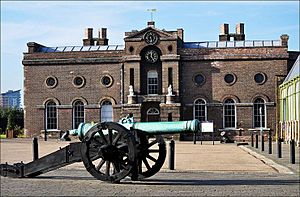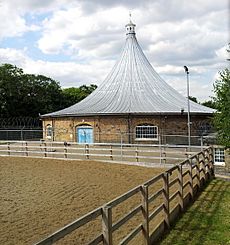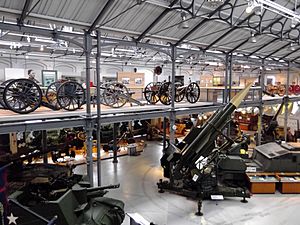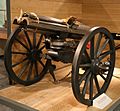Royal Artillery Museum facts for kids
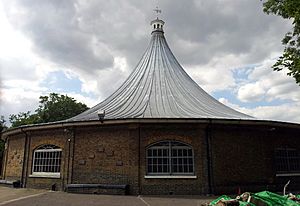
The Rotunda, Woolwich: home of the museum from 1820 to 2001
|
|
| Established | 4 May 1820 |
|---|---|
| Dissolved | 8 July 2016 |
The Royal Artillery Museum was once one of the oldest military museums in the world! It first opened in Woolwich, southeast London, in 1820. This museum showed how artillery (big guns and cannons) changed over many centuries. It had a huge collection of artillery pieces from different times.
The museum actually started from an older place called the Royal Military Repository. This Repository began in Woolwich in the 1770s. It was a training collection for young soldiers at the Royal Military Academy. Many items from this early collection became the main part of the Royal Artillery Museum.
The museum, later known as 'Firepower – The Royal Artillery Museum', closed in 2016. Its amazing collection is now kept safely in storage. There are plans to open a new Royal Artillery Museum in the future. Experts at Arts Council England say these collections are very important for the whole country and even the world.
Contents
The Museum's History
The story of the Royal Artillery Museum began in the 1700s in Woolwich. This area was home to the Royal Arsenal, a place where weapons were made. In 1716, two groups of soldiers, each with 100 men, were formed here. They worked with field artillery. By 1720, this group became known as the "Royal Artillery." In 1741, a special school, the Royal Military Academy, was also set up here. It trained future artillery and engineer officers.
Early Training: The Royal Military Repository
In 1778, a captain named William Congreve started a training center. It was part of the Royal Military Academy. This center taught officers how to use heavy equipment on the battlefield. It was called the 'Repository of Military Machines', and soon became the Royal Military Repository.
The Repository was in a long, two-story building. Cannons for field training were kept on the ground floor. Smaller items and models for teaching were shown upstairs. The training grounds nearby are still called 'Repository Grounds' today.
Sadly, the Repository building was badly damaged by fire in 1802. The items that were saved found a new home. They moved into the old Royal Military Academy building. The Academy itself moved to a new location in 1806.
A Unique Home: The Rotunda Museum
In 1820, the Repository collection found a very special new home. It was a round building called the Rotunda. This building was first built in London in 1814 as a fancy, temporary tent. It was for a party given by the Prince Regent. The party celebrated the Duke of Wellington's expected victory over Napoleon Bonaparte. The Rotunda looked like a military bell tent.
After the celebrations, the building wasn't used. But in 1818, the Prince Regent allowed it to be moved to Woolwich. It was rebuilt there to hold "trophies obtained in the last war, the artillery models, and other military curiosities." It was placed on the edge of the Repository Grounds.
In its new, easy-to-reach spot, the Repository became an early public museum that was free to visit. Inside, war trophies and weapons were arranged around a central pole. Display cases held models and smaller items. Larger artillery pieces were shown outside.
The museum stayed in the Rotunda until the end of the 1900s. Even though there were many ideas to move it, it remained there. Finally, a new place was found for the museum in the old Royal Arsenal. The Royal Artillery Museum in the Rotunda closed in 1999.
Firepower: The Royal Artillery Museum
From 2001 to 2016, the museum was known as Firepower: The Royal Artillery Museum. It was located in some of the old buildings of the Royal Arsenal. These buildings were once part of the Royal Laboratory Department, which made ammunition. Many of them are important historic buildings. Next door, the Greenwich Heritage Centre told stories about the local people who worked in the Arsenal.
Museum Closure
Firepower closed in July 2016. The buildings were bought by Greenwich Council. The council hoped to create a "new cultural and heritage quarter" in the area. The museum's move was seen by some as a missed chance. Later that year, the Greenwich Heritage Centre helped fill the gap. It created a new exhibition called Making Woolwich: The Royal Regiment of Artillery in Woolwich.
Future of the Buildings
In 2017, it was announced that Greenwich Council bought five historic buildings. These buildings are around No 1 Street. The plan was to create a £31 million cultural area. This included buildings 17, 18, and 41, which Firepower had used. The plan also included a 450-seat theater. Building 17 would house studios for performing arts groups. The Greenwich Heritage Centre was meant to move to the former James Clavell Library. This library was part of Firepower until 2016, but it closed in July 2018.
Gallery of Buildings
These buildings were used by Firepower:
-
To the left, the former Royal Laboratory Offices (Building 18) housed museum offices and archives.
-
Building 41 (across from the main museum) showed large Cold War-era exhibits.
Gallery of Exhibits
Future Plans for the Museum
There were plans for the Royal Artillery Museum collection to be shown in a new museum. This new museum would be on Salisbury Plain, at Avon Camp West. However, in 2020, the Army decided not to support the chosen site. This led to a new look at the whole project. For now, the museum's items are being stored and cared for nearby. There is only limited public access to them.


